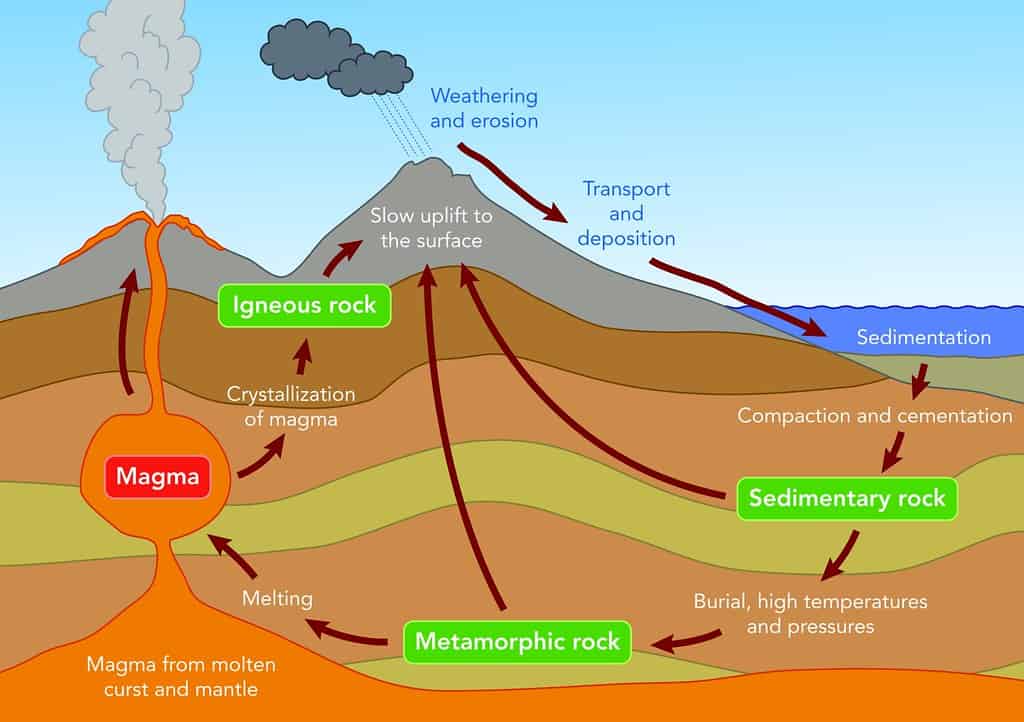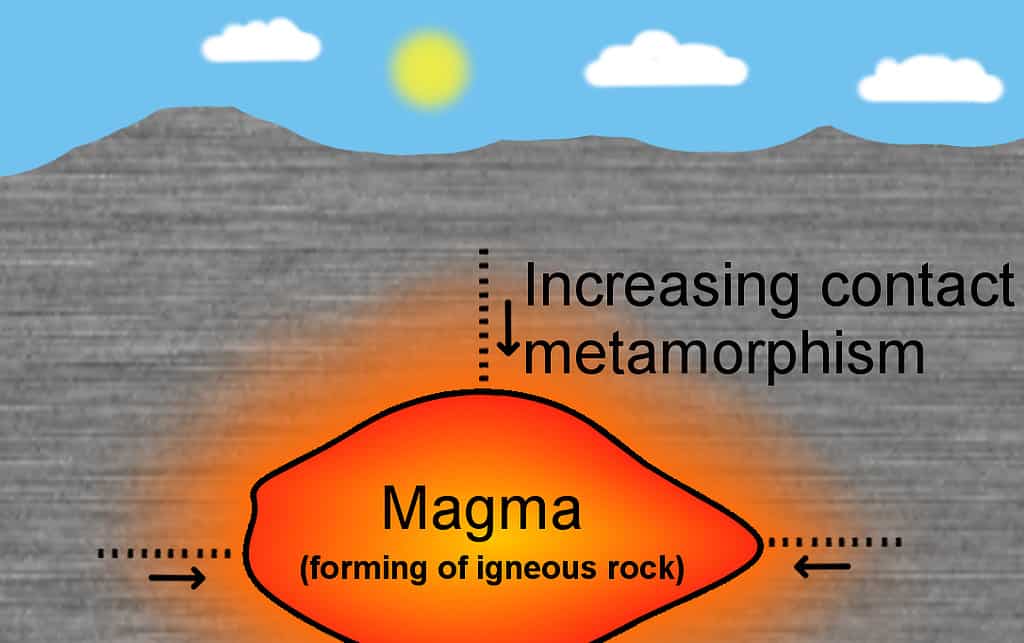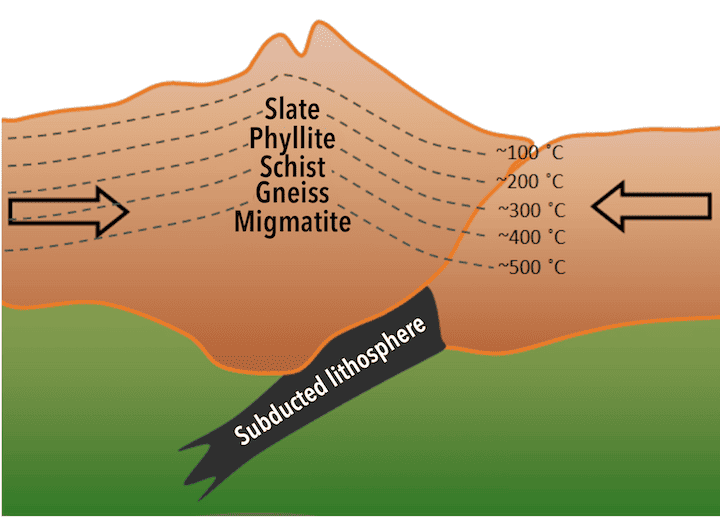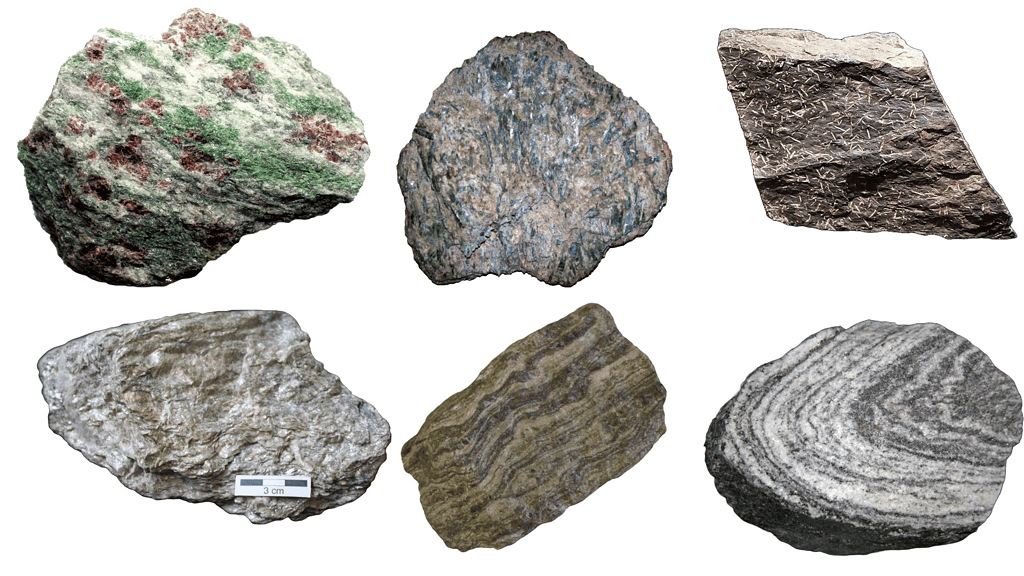Metamorphic rocks are a category of rocks formed from the transformation of existing rock types. This happens due to the influence of high pressure, high temperature, and chemically active fluids within the Earth’s crust. This metamorphic process alters the mineral composition and structural texture of the original rock, resulting in a new type of rock with distinct physical and chemical properties.
Unlike igneous rocks, which are born from molten magma, and sedimentary rocks, which are formed from the deposition of material at the Earth’s surface, metamorphic rocks are crafted from the reworking of existing rocks deep within the Earth. Their formation is often associated with tectonic activities, such as mountain building, making them vital to understanding Earth’s internal processes and its geologic past.

The Birth of Metamorphic Rocks
There are many ways through which metamorphic rocks can be formed. Fluids, particularly water, play a crucial role in the metamorphic process. They act as catalysts, facilitating chemical reactions that alter the mineral composition of the protolith. These fluids can be derived from the protolith itself or from external sources, such as infiltrating groundwater.
However, metamorphic rocks generally require heat and/or pressure to form.
The Role of Heat and Pressure

Metamorphic rocks begin their life cycle as something entirely different. They are born from the transformation of existing rocks, known as ‘protoliths’, which can be igneous, sedimentary, or even older metamorphic rocks. This transformation is not just a surface alteration but a profound change in mineral composition and texture.
The primary agents of metamorphism are heat and pressure. Heat can be sourced from nearby magma intrusions or the increasing temperature with depth in the Earth’s crust. Pressure, on the other hand, arises from tectonic forces, such as the collision of continental plates, or the immense weight of overlying rock. These forces work together, but their relative influence can vary, leading to different types of metamorphic rocks.
Types of Metamorphism
If we want to see how metamorphic rocks are formed, we need to first discuss the type of metamorphism that forms them. There’s not just one type of metamorphism, there are several types.
Contact Metamorphism

Contact metamorphism occurs when rocks are heated by proximity to magma. This process typically affects a relatively small area and results in the formation of rocks like marble and quartzite. The key characteristic here is the impact of heat, with pressure playing a less significant role.
Regional Metamorphism
Regional metamorphism, in contrast, involves large-scale tectonic processes and affects vast areas of the Earth’s crust. This type of metamorphism is associated with mountain-building events where intense pressure and heat lead to widespread rock alteration. Rocks like schist and gneiss are typical products of regional metamorphism.
Hydrothermal Metamorphism
In the process of hydrothermal metamorphism, rocks undergo alteration due to the impact of hydrothermal fluids at high temperatures and moderate pressures. This type of metamorphism is particularly prevalent in basaltic rocks, which typically lack water-rich minerals. Through hydrothermal metamorphism, minerals rich in magnesium and iron, such as talc, chlorite, serpentine, actinolite, tremolite, zeolites, and various clay minerals, are formed. This process is also known for creating substantial ore deposits.
Burial Metamorphism
Burial metamorphism occurs when sedimentary rocks are deeply buried, reaching several kilometers below the Earth’s surface. In these conditions, temperatures can exceed 300°C without the presence of differential stress. Under such circumstances, new minerals, primarily zeolites, begin to form, yet the rocks do not exhibit typical signs of metamorphism. This process shares some similarities with diagenesis and can transition into regional metamorphism as temperature and pressure continue to rise.

How metamorphism changes rock texture
During metamorphism, minerals within the protolith can undergo recrystallization, where existing minerals change shape and size without melting. New minerals may also form, suited to the new temperature and pressure conditions. This process not only changes the rock’s composition but also its texture, often giving metamorphic rocks a foliated or banded appearance.
How to identify Metamorphic Rocks

Metamorphic rocks are identified by their distinct textures and mineral compositions. Foliation, the alignment of mineral grains or layers in the rock, is a common feature, seen in rocks like slate and schist. Non-foliated rocks like marble and quartzite lack this layered appearance but have a crystalline texture due to recrystallization.
Examples of how metamorphic rocks are formed
Let’s give some examples and see some of the most common types of metamorphic rock and how they’re formed.
1. Slate
- Origin: Slate originates from the metamorphism of shale or mudstone under relatively low-grade metamorphic conditions.
- Formation Process: It forms through the realignment of fine clay minerals under directed pressure, resulting in a foliated structure with distinct layers.
- Characteristic Features: Known for its fine grain and ability to split into thin sheets, slate is often used in roofing and flooring.
2. Schist
- Origin: Schist is typically formed from the metamorphism of clay-rich sedimentary rocks like mudstone.
- Formation Process: It undergoes higher-grade metamorphism than slate, leading to the growth of larger mica crystals, giving it a shiny appearance and pronounced foliation.
- Characteristic Features: Schist is recognizable by its glittery surface and the ease with which it splits along mica-rich layers.
3. Gneiss
- Origin: Gneiss can form from high-grade metamorphism of various protoliths, including igneous rocks like granite and sedimentary rocks.
- Formation Process: It is characterized by extreme pressure and temperature conditions that result in the segregation of mineral bands, giving it a banded appearance.
- Characteristic Features: Gneiss is known for its distinct banding and varied composition, with alternating layers of light and dark minerals.
4. Marble
- Origin: Marble is a product of the metamorphism of limestone or dolostone.
- Formation Process: Under the influence of heat and pressure, the calcite or dolomite in these rocks recrystallizes into a denser, coarser crystalline structure.
- Characteristic Features: Famous for its use in sculpture and architecture, marble is prized for its smooth texture and variety of colors.
5. Quartzite
- Origin: Quartzite forms from the metamorphism of quartz-rich sandstone.
- Formation Process: The quartz grains in the sandstone recrystallize under heat and pressure, fusing together to form a hard, dense rock.
- Characteristic Features: Quartzite is extremely hard and resistant to weathering, with a glassy luster and a range of colors depending on impurities.
6. Phyllite
- Origin: Phyllite is an intermediate-grade metamorphic rock that forms from the further metamorphism of slate.
- Formation Process: This process involves higher temperatures and pressures than those that form slate, leading to the development of larger mica crystals.
- Characteristic Features: Phyllite is characterized by its lustrous sheen and wavy appearance, with visible but small mica crystals.
7. Amphibolite
- Origin: Amphibolite can form from the metamorphism of igneous rocks like basalt or gabbro, as well as from sedimentary rocks.
- Formation Process: It is formed under medium to high-grade metamorphic conditions, leading to the growth of amphibole minerals and plagioclase feldspar.
- Characteristic Features: Amphibolite is known for its dark color and hornblende-rich composition, often used in construction and as a decorative stone.
8. Serpentinite
- Origin: Serpentinite forms from the metamorphism of ultramafic rocks, typically peridotite, which comes from the Earth’s mantle.
- Formation Process: The metamorphism occurs at low temperatures but high pressures, especially in subduction zone settings, leading to the formation of serpentine minerals.
- Characteristic Features: Serpentinite is notable for its greenish color and smooth, sometimes waxy surface, often associated with asbestos.
9. Blueschist
- Origin: Blueschist forms from the high-pressure, low-temperature metamorphism of basaltic rocks in subduction zones.
- Formation Process: This unique environment results in the formation of blue amphibole minerals, giving the rock its distinctive color.
- Characteristic Features: Blueschist is known for its blue to bluish-green color and the presence of glaucophane, a blue amphibole mineral.
10. Eclogite
- Origin: Eclogite forms from very high-pressure metamorphism of basalt or gabbro, typically in the upper mantle.
- Formation Process: The extreme pressure conditions lead to the growth of garnet and omphacite, a pyroxene mineral.
- Characteristic Features: Eclogite is distinctive for its bright green and red minerals (omphacite and garnet, respectively), indicating its formation in deep subduction zones.
So, there is a wide variety of processes through which metamorphic rocks can be formed. To understand this type of rock, you need to have a pretty solid grasp of basic geological processes. Metamorphic rocks encode within them a lot of our planet’s history — and if you know how to listen, they can tell some good stories.






